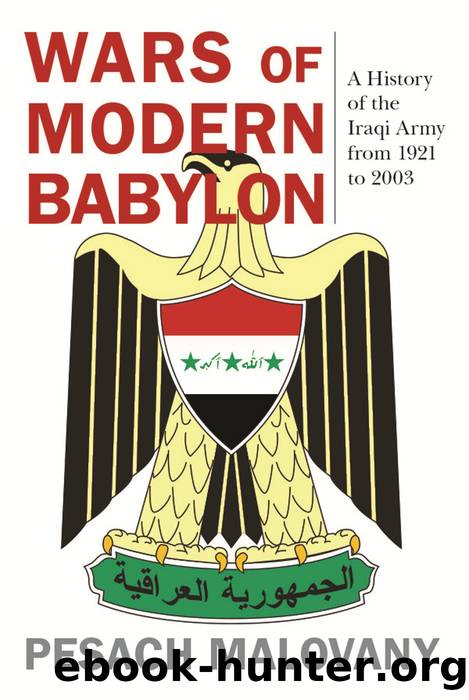Wars of Modern Babylon by MALOVANY PESACH

Author:MALOVANY, PESACH.
Language: eng
Format: epub
Publisher: University Press of Kentucky
Published: 2017-11-14T16:00:00+00:00
General background
The Iraqi Air Force was the second most important arm in the war against Iran from its outbreak. This war constituted the air armâs most significant operational experience since the participation of a number of its squadrons on the Syrian and Egyptian fronts in the 1973 war against Israel.
In the course of the war, the air force performed more than 400,000 sorties.15 It played a significant role in bringing about Iranâs military and economic defeat. As Saddam commented in a visit to the armâs headquarters in February 1986: âHalf of the armed forcesâ successes in the war are to the credit of the air force, and the other half to the rest of the arms.â16
During the war, the air force fought to its full capacity and for extended periods of time, with a growing number of planes taking part in a variety of missions. The arm expanded in terms of the number of planes and pilots, and it absorbed new weapon systems; it had learned important lessons that improved its operational capabilities and transformed it by the end of the war into a force to be reckoned with, and a significant regional threat. The arm reached a high performance level by exploiting its new power and capabilities to the full, which were especially evident compared to the weakness of the Iranian Air Force, as appeared in various aspects of aerial warfare throughout the war.
The arm underwent a transformation as the war progressed; initially it had limited capabilities and was inferior to the Iranian Air Force, which was considered during the shahâs reign to be one of the most advanced in the region. The numerical ratio between the planes held by the two air forces was 1:4 in Iranâs favor when the war broke out. Absorbing new systems and applying lessons learned during the war tipped the scales in Iraqâs favor in fighting capabilities, as expressed in its constantly improving performance.
Most of the planes in service during the war against Iran and afterward were of Soviet manufacture: Mig-21, -23, -25, and -29 fighter planes; Sukhoi-7, -20, -22, -24, and -25 fighter-bombers; Tupolev-16 and -22 bombers; Antonov and Ilyushin transport and support planes; and training planes of various types, including planes of Czech origin. To these were added during the war French-made Mirage F-1 and Super Ãtendard planes, and Chinese planes, which were facsimiles of Soviet Mig planes (F-6s and F-7s, which were copies of Mig-19s and Mig-21s, respectively) and H-6D/B-6D (TU-16) bombers. The intensive effort invested in building up the force paid off, as by the end of the war Iraqâs air force was far more powerful and of a higher quality than it had been at the beginning. In addition, the level of the Iraqi pilots rose, both in the number of missions to their credit and their performance level, whether in attack missions, interceptions, or air battles, even though this was the first operational experience for most of them.
The continued improvement of the air arm and its performance
Download
This site does not store any files on its server. We only index and link to content provided by other sites. Please contact the content providers to delete copyright contents if any and email us, we'll remove relevant links or contents immediately.
| Africa | Americas |
| Arctic & Antarctica | Asia |
| Australia & Oceania | Europe |
| Middle East | Russia |
| United States | World |
| Ancient Civilizations | Military |
| Historical Study & Educational Resources |
Never by Ken Follett(2877)
The Man Who Died Twice by Richard Osman(2293)
Machine Learning at Scale with H2O by Gregory Keys | David Whiting(2278)
Fairy Tale by Stephen King(2061)
Will by Will Smith(2039)
Rationality by Steven Pinker(1763)
The Dawn of Everything: A New History of Humanity by David Graeber & David Wengrow(1569)
The Dark Hours by Michael Connelly(1565)
Principles for Dealing With the Changing World Order: Why Nations Succeed and Fail by Ray Dalio(1373)
Friends, Lovers, and the Big Terrible Thing by Matthew Perry(1326)
A Short History of War by Jeremy Black(1297)
HBR's 10 Must Reads 2022 by Harvard Business Review(1253)
Go Tell the Bees That I Am Gone by Diana Gabaldon(1233)
Can't Hurt Me: Master Your Mind and Defy the Odds - Clean Edition by David Goggins(1225)
515945210 by Unknown(1206)
Fear No Evil by James Patterson(1107)
443319537 by Unknown(1071)
Works by Richard Wright(1017)
Going There by Katie Couric(991)
